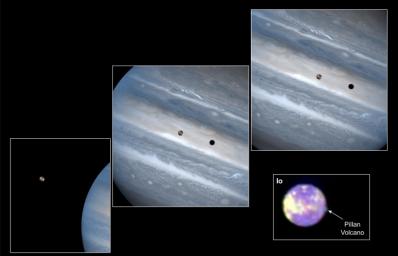
|
Hubble Clicks Images of Io Sweeping Across Jupiter
- Click the image above for a larger view
- Full-Res JPEG (3000 x 1930) (285.7 kB)
- Full-Res TIFF (3000 x 1930) (6.2 MB)
Caption:
While hunting for volcanic plumes on Io, NASA's Hubble Space Telescope captured these images of the volatile moon sweeping across the giant face of Jupiter. Only a few weeks before these dramatic images were taken, the orbiting telescope snapped a portrait of one of Io's volcanoes spewing sulfur dioxide "snow."
These stunning images of the planetary duo are being released to commemorate the ninth anniversary of the Hubble telescope's launch on April 24, 1990. All of these images were taken with the Wide Field and Planetary Camera 2.
The three overlapping snapshots show in crisp detail Io passing above Jupiter's turbulent clouds. The close-up picture of Io (bottom right) reveal a 120-mile-high (200-kilometer) plume of sulfur dioxide "snow" emanating from Pillan, one of the moon's active volcanoes.
"Other observations have inferred sulfur dioxide 'snow' in Io's plumes, but this image offers direct observational evidence for sulfur dioxide 'snow' in an Io plume," explains John R. Spencer of Lowell Observatory in Flagstaff, Ariz.
A Trip Around Jupiter
The three snapshots of the volcanic moon rounding Jupiter were taken over a 1.8-hour time span. Io is roughly the size of Earth's moon but 2,000 times farther away. In two of the images, Io appears to be skimming Jupiter's cloud tops, but it's actually 310,000 miles (500,000 kilometers) away. Io zips around Jupiter in 1.8 days, whereas the moon circles Earth every 28 days.
The conspicuous black spot on Jupiter is Io's shadow and is about the size of the moon itself (2,262 miles or 3,640 kilometers across). This shadow sails across the face of Jupiter at 38,000 mph (17 kilometers per second). The smallest details visible on Io and Jupiter measure 93 miles (150 kilometers) across, or about the size of Connecticut.
These images were further sharpened through image reconstruction techniques. The view is so crisp that one would have to stand on Io to see this much detail on Jupiter with the naked eye.
The bright patches on Io are regions of sulfur dioxide frost. On Jupiter, the white and brown regions distinguish areas of high-altitude haze and clouds; the blue regions depict relatively clear skies at high altitudes.
These images were taken July 22, 1997, in two wavelengths: 3400 Angstroms (ultraviolet) and 4100 Angstroms (violet). The colors do not correspond closely to what the human eye would see because ultraviolet light is invisible to the eye.
Io: Jupiter's Volcanic Moon
In the close-up picture of Io (bottom right), the mound rising from Io's surface is actually an eruption from Pillan, a volcano that had previously been dormant.
Measurements at two ultraviolet wavelengths indicate that the ejecta consist of sulfur dioxide "snow," making the plume appear green in this false-color image. Astronomers increased the color contrast and added false colors to the image to make the faint plume visible.
Pillan's plume is very hot and its ejecta is moving extremely fast. Based on information from the Galileo spacecraft, Pillan's outburst is at least 2,240 degrees Fahrenheit (1,500 degrees Kelvin). The late bloomer is spewing material at speeds of 1,800 mph (2,880 kilometers per hour). The hot sulfur dioxide gas expelled from the volcano cools rapidly as it expands into space, freezing into snow.
Io is well known for its active volcanoes, many of which blast huge plumes of volcanic debris into space. Astronomers discovered Pillan's volcanic explosion while looking for similar activity from a known active volcano, Pele, about 300 miles (500 kilometers) away from Pillan. But Pele turned out to be peaceful. Io has hundreds of active volcanoes, but only a few, typically eight or nine, have visible plumes at any given time.
Scientists will get a closer look at Io later this year during a pair of close flybys to be performed by NASA's Galileo spacecraft, which has been orbiting Jupiter and its moons for nearly 3-1/2 years.
The first Galileo flyby is scheduled for Oct. 10 at an altitude of 379 miles (610 kilometers), and the other will occur on Nov. 25, when the spacecraft will fly only 186 miles (300 kilometers) above Io's fiery surface. If the spacecraft survives this daring journey into the intense Jovian radiation environment near Io, it will send back images with dramatically higher resolution than any obtained before, according to mission scientists.
The Hubble telescope image of Io's volcanic plume is a composite taken July 5, 1997, in three wavelengths: 2600 Angstroms (ultraviolet), 3400 Angstroms (ultraviolet), and 4100 Angstroms (violet).
Cataloging Keywords:
| Name | Value | Additional Values |
|---|---|---|
| Target | Io | Jupiter |
| System | Jupiter | |
| Target Type | Satellite | Planet |
| Mission | Hubble Space Telescope (HST) | Galileo |
| Instrument Host | Hubble Space Telescope | Galileo Orbiter |
| Host Type | Space Telescope | Orbiter |
| Instrument | Wide Field/Planetary Camera 2 (WFPC2) | |
| Detector | ||
| Extra Keywords | Atmosphere, Color, Haze, Moon, Plume, Shadow, Ultraviolet, Volcano | |
| Acquisition Date | ||
| Release Date | 1999-05-21 | |
| Date in Caption | 1990-04-24 | 1997-07-05, 1997-07-22 |
| Image Credit | NASA/JPL/STScI | |
| Source | photojournal.jpl.nasa.gov/catalog/PIA01540 | |
| Identifier | PIA01540 | |
